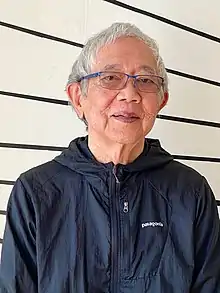Al Wong
Al Wong (born 1939) is an American artist and educator, known for his experimental film and mixed media installation art.[1][2] He is based in San Francisco, California.[3]
Al Wong | |
|---|---|
 | |
| Born | 1939 (age 83–84) |
| Alma mater | Academy of Art University, San Francisco Art Institute |
| Occupation(s) | artist, fine art professor |
| Years active | 1968-Present |
| Known for | Experimental filmmaking, mixed media installation art |
| Website | https://alwongart.com/ |
Biography
Al Wong was born in 1939 in San Francisco, California to father Willie Wong.[1][3] He attended San Francisco Academy of Art University from 1960 until 1962 and the San Francisco Art Institute (SFAI), from 1962 until 1968 and again in 1970 until 1971.[1] He received a Masters of Fine Arts degree in 1972 from SFAI.[4] He also studied with Shunryu Suzuki Roshi at the San Francisco Zen Center.[5]
He taught classes at San Francisco Art Institute from 1975 until 2003,[1] as well working as a lecturer at California State University, Sacramento from 1975 until 1977; and as an associate professor at Sonoma State University.[1]
Wong started making films around 1965, with his first film screening in 1967 at the Expo 67 in Montreal, Canada.[4] Wong's work was included in the, Other Sources: An American Essay (1976) multidisciplinary, multiethnic exhibition curated by Carlos Villa.[6] In addition to filmmaking and film installation art, Wong also has created works on paper, light installations and photo installations.
Wong was awarded the Guggenheim Fellowship in Film (1986),[7] and the Flintridge Foundation grant (1998).[8][2]
Filmography
| Year | Title | Type | Length | Notes |
|---|---|---|---|---|
| 1975 | Same Difference | 16mm film, color, sound | 17.5 minutes | The soundtrack is by Terry Fox.[3] Same Difference was filmed in a kitchen window over the span of a years time.[3] |
| 1976 | Corner | double 16mm film projection on wall corner, black-and-white, silent | 16 minutes | [3][4] |
| 1977 | 24 F.P.S. | [9][10] | ||
| 1977 | Twin Peaks | 16mm transferred to video, sound | 50 minutes | This film was featured in solo viewings at San Francisco Museum of Modern Art (SFMoMA) and Museum of Modern Art (MOMA).[3][11] |
| 1979 | Shadow and Chair | 16mm film installation, black-and-white, silent | 10.5 minutes | [3] |
| 1980 | Moon Stand | 16mm film installation, black-white, sound | 14 minutes | [3] |
References
- "Artist Results, Al Wong". San Francisco Arts Commission. Retrieved 2020-11-29.
- The Visual Artists Awards: Flintridge Foundation, 1997/98. Flintridge Foundation. 1998. p. 43. ISBN 978-0-9664721-0-3.
- Zimbardo, Tanya (May 3, 2013). "Sunlight and Shadows: Al Wong in Conversation". SFMOMA Open Space, San Francisco Museum of Modern Art. Retrieved 2020-11-29.
- Walley, Jonathan (2020). Cinema Expanded: Avant-Garde Film in the Age of Intermedia. Oxford University Press. p. 381. ISBN 978-0-19-093863-5.
- Chang, Gordon H. (2008). Asian American Art: A History, 1850-1970. Stanford University Press. p. 424. ISBN 978-0-8047-5751-5.
- Johnson, Mark (September 11, 2013). "1976 and Its Legacy: Other Sources: An American Essay at San Francisco Art Institute". Art Practical. Retrieved November 28, 2020.
- "Fellows: Al Wong". John Simon Guggenheim Foundation. Retrieved 2020-11-29.
- Bonetti, David (1998-08-17). "Grants for Bay artists, museums". SFGATE. Retrieved 2020-11-29.
- "24 f.p.s." CineFiles, Berkeley Art Museum and Film Archive (BAMFA), University of California, Berkeley. Retrieved 2020-11-29.
- "Al Wong". Alternative Projections. Retrieved 2020-11-29.
- "Al Wong: Twin Peaks at San Francisco Museum of Modern Art in San Francisco". SF Station. May 7, 2013. Retrieved 2020-11-29.